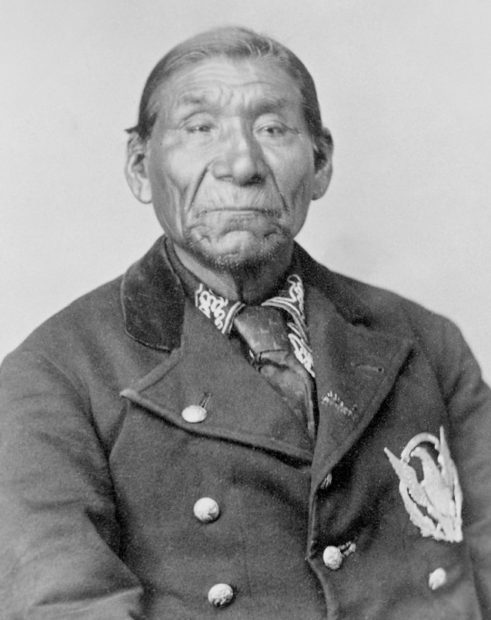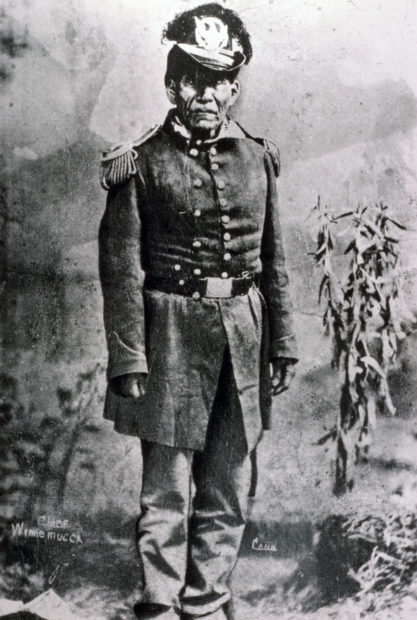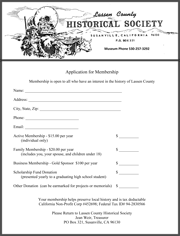

by Susan Couso
The name ‘Winnemucca’ has appeared throughout the western U. S. for many years now. Legends and historical facts seem to blur together to create a man, Chief Winnemucca, who could probably not live up to the many tales surrounding his life.
His role in history may be somewhat questionable and controversial, but Chief Winnemucca was a powerful force in the area around Pyramid Lake and throughout northeastern California and western Nevada. He was not a savage, but he was a warrior for his people.
He was born, Poito, around 1820, at the sink of the Humbolt River, but the year is, of course, unsure. The Shoshone People had no need for the numerical dates placed upon the passing of time.
Most historians say that Poito was the son of Chief Truckee. This is most probably true, but some dispute this, and we will never know the truth.
Poito married Tuboitonie, the daughter of Paiute chief, Old Winnemucca. As part of the marriage ceremony, he was given the name, Winnemucca, by his new father-in-law. The name Winnemucca has been given several meanings, but it’s true interpretation is unclear. It reportedly means, ‘bad face’, ‘one moccasin’, or ‘giver of spiritual gifts.’
Poito, or Young Winnemucca was born a Shoshone, but became a member of the Kuyuidika band of the Northern Paiute upon his marriage. This followed tribal customs which had existed for hundreds, if not thousands, of years.
Poito, (now Winnemucca) spent a childhood secure in the knowledge that life was orderly and changed very little. It had been nearly the same since ‘time began’. As he grew older, he heard stories of strange people appearing from unknown far-away places, but they were just stories, perhaps meant to teach one of life’s lessons.
Then, Winnemucca’s father, Truckee, actually met these strangers.
Truckee was a powerful and important man ‘in his own right’. He was said to have had a vision many years before the emigrants had ever arrived in the area. In his vision he had seen these strange people with their horses and wagons. As the emigrants finally appeared, Truckee welcomed them with open arms, and helped them find their way through the mountains.
Old Chief Truckee was amazed and trustful of the settlers coming into the area, but Winnemucca was more restrained and cautious. He was a major proponent of the 1860 Pyramid Lake War. The war was instigated against the encroaching emigrants who were lured to the area seeking gold and silver, and it spread into Honey Lake Valley and caused great concerns among the settlers there.
The Native People were eventually defeated, and Winnemucca lost not only his wife and some of his children to this war, but also much of his power with his people.
Winnemucca foretold of the coming time when the Native People would no longer be free to use their land. Still, in most cases, he worked to negotiate and prevent hostilities. He undoubtedly saw the futility of protesting such a massive emigration, that never seemed to stop. Attempting to work with people could be a more advantageous path.
This was a time of intolerance by people on both sides of the issue, but Winnemucca seemed to understand that the only method to a future for his people was through peace.

In 1880 Winnemucca traveled to Washington, D.C. to speak to government officials, in an attempt to understand their ways, and also to negotiate for his people.
He was accompanied by his son, Nachez, Captain Jim, and his daughter Sarah, who interpreted for the Paiutes. The group of Northern Paiute met with Secretary of the Interior Carl Schurz and President Rutherford B. Hayes to discuss their grievances. This voyage through an unknown world must have influenced Winnemucca’s decisions for the rest of his life.
Even with his distrust of the mass of settlers moving through his land, Winnemucca developed a good working relationship with many of them. His friendship with Isaac Roop was well known, with Roop defending and protecting him from local assaults.
Winnemucca and Roop visited many times, and Winnemucca journeyed to Susanville and stayed in Roop’s home on several occasions. Susan Roop, Isaac’s daughter, was known to offer Winnemucca her gracious hospitality.
Winnemucca worked with the U.S. Army to negotiate with various Paiute bands and was given an army uniform for his assistance. Many tribal members were disgusted and discouraged to see Winnemucca in his new uniform and felt that their chief had betrayed the Paiutes. Still, proud to have been honored by the U.S. Army, he continued working to appease them all.
Winnemucca’s daughter, Sarah, was fluent in English, as were many in her family. She lectured and told of her experiences in ‘Life Among the Piutes’, written in 1883. She, of course, promoted her father to a high position in his tribe, calling him the chief of all the Northern Paiutes. This may be true, but modern historians only note that he was a man of considerable influence among his people.
In October of 1882, Winnemucca died, probably of poisoning, at Coppersmith Station, Nevada. His young wife was accused of ‘bewitching’ him. As was the custom of Winnemucca’s people, she was thrown into a pit with their three-year-old child, and the two were stoned to death.
Winnemucca’s descendants are said to still live in the area where he resided, and the town of Winnemucca, Nevada, along with many other sites, is named for him. His son, Natchez, and his nephew, Numaga were called Little Winnemucca and Young Winnemucca.
Winnemucca’s place in history is indisputably a large one. He lived at a time when his people faced huge challenges, and his decisions seem to have helped many of them understand and deal with the changes in their world.
Winnemucca’s name alone recalls the time when a culture and a people, thousands of years in the making, were removed from their lands.

If you are a fan of our weekly history stories you should join the Lassen County Historical Society! It’s a fun way to be a part of our county’s rich history. When you sign up, you’ll receive regular Historical Society newsletters with interesting stories and information. Membership is open to anyone with an interest in area history.
Through your membership you help preserve local history. You can download a membership application by clicking here.







